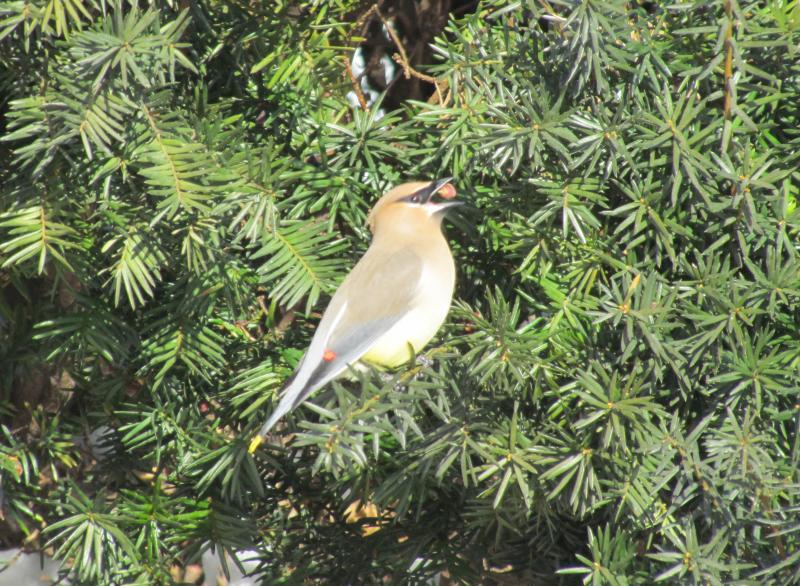A bird of mystery
We have long been enamored of cedar waxwings. There are so many things that make them interesting. Along with the blue jay, tufted titmouse, and northern cardinal, they are one of the few Maine songbirds with a pronounced tuft or crest on the head. That automatically makes them “cool.” Add to that their sleek tan plumage, mysterious super hero black mask, bright yellow tail tip, and colorful red waxy feather tips and you’ve got a strikingly beautiful bird.
But there’s more. Cedar waxwing vocalizations are fascinating, too: soft, high-pitched, drawn-out hisses that most people never notice or, if they do, may never equate with a bird song. Which means once you learn their sound, you’ll find yourself identifying them even when they’re flying hundreds of feet over your head.
Waxwings are so named because they have, on the tips of the inner flight feathers (the wing feathers closest to the body ), red, waxy tips. On a perched cedar waxwing, these tips will appear like a red band about a third of the way back from the tip of the wing. It’s unclear whether or not the red waxy tips serve a particular purpose, though some have postulated that they may have something to do with mate attraction. It is known that it normally takes at least a year for birds to develop these tips, so they are at least a reliable signal of maturity to a potential mate.
Cedar waxwings occur in flocks most of the year, and even though nesting and rearing of young is done in pairs, often the nest sites are close enough together such that they are considered “semicolonial nesters” in those situations. From spring into early summer, one often finds flocks of cedar waxwings in flowering trees — crabapples and apples in May, sometimes flowering locust trees in June — eating the blossoms and presumably also getting nectar and insects. A behavior of cedar waxwings that we humans tend to find quite charming is when one bird passes a flower petal to another. Generally, this behavior is involves a male passing a food item to the female as part of courtship, something that’s not uncommon in other bird species. For example, many people may have seen male northern cardinals passing seeds to a female in the spring. But in waxwings, the behavior can be harder to interpret. Two birds will sometimes pass a petal or fruit back and forth between them and, since we humans can’t tell male form female, it is hard to know who is doing what. Then there are the cases when a food item may be passed back and forth between more than two waxwings sitting together on a branch. Who knows what is going on there!
Here in Maine, we have cedar waxwings around all year, though they migrate south in large numbers from the northern edge of their extensive North American breeding range. In winter they occur across the southern U.S. and south into Mexico and Central America, in some years making it down into Panama. In winter, they are joined here in Maine by their larger cousin the Bohemian waxwing with its cinnamon undertail coverts and white wing patches. Both species are incredible wanderers, and banding studies have found almost no returns of banded birds to the places where they were originally banded.
There are lots of cedar waxwings in Maine this summer. Enjoy this international bird of mystery while you can!
Event Date
Address
United States























